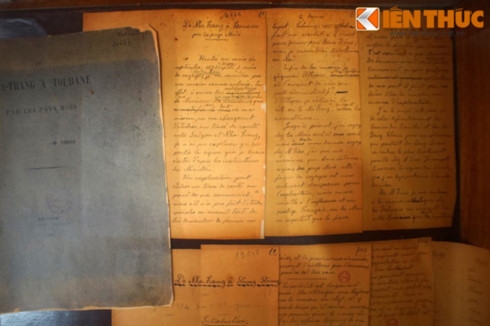The Alexandre Yersin Museum is located on the 2nd floor of the Nha Trang Pasteur Institute, which he founded in 1895.
The 100-square-meter museum features his collection of books, from fairy tales to classic literature, his hand-written letters, photographs from his travels around Vietnam, laboratory equipment, and other personal belongings of an erudite scholar in all fields of medicine, astronomy, geography, science, and art.
Yersin, as a 28-year-old French man, first set foot on the Nha Trang coast in 1891, pursuing a dream of tropical forest exploration.
    |
 |
|
On display are numerous Yersin's hand-writing pieces such as his travel diary and letters to friends. Source: kienthuc.net.vn |
Called by locals Mr. Tu, Yersin was the first European to provide health services in the region. Photos on display at the museum show a kind-hearted man who treated his Vietnamese patients for free and enthusiastically supported the poor fishermen who lived in Con village where he had his home.
Yersin especially loved children, who came to his house to read books, watch films, and play with his telescope.
Quach Giao, who was one of those children, recalled, “Mr. Tu used to screen films on Thursday and Saturday afternoon. We children loved films about animals and Charlie Chaplin comedies. Local people learned a lot from him.”
The museum documents a period in which Yersin lived a secluded life and made prominent studies in medicine, bacteriology, geography, astronomy, and art.
He worked to cure the bubonic plague and discovered Lam Vien plateau, where in 1899 the French administration built a resort city, known today as Da Lat.
Yersin was the first to introduce the rubber tree to Vietnam. In 1902, Governor General Paul Doumer invited Yersin to Hanoi to discuss establishing of the Indochina Medical College, now the Hanoi Medical University, where Yersin served as principal.
Thanks to Yersin’s research, the French administration in Indochina established Vietnam’s first research agencies in geography, meteorology, astrology, and oceanography.
Nguyen Hoang Doan Thuc, manager of the Alexandre Yersin Museum, said, “The Museum has Yersin’s astronomical map and his detailed records on storms that struck Nha Trang between 1909 and 1942. There are also 20 books in which Yersin recorded tidal waves. These are precious documents that lead to the establishment of the Oceanographic Institute.”
In addition to the museum, there are other reminders of Yersin in Nha Trang, including Yersin Park along the Nha Trang coast with a 4-meter-high Yersin statue and Yersin’s grave, 20 kilometers from Nha Trang, which draws crowds of pilgrims each year.
Locals built a shrine there to commemorate Yersin’s contributions to Vietnam. In 1990, Yersin’s grave complex and the Alexandre Yersin Museum were recognized as national historical relics, the first time this honor was accorded to a foreigner.
Source: VOV5